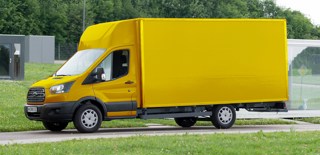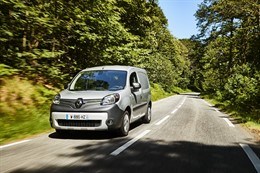UK industry newcomer, BD Auto, looks to convert diesel fleets to electric vehicles by offering to rent them vans with a promise to match wholelife costs
In the van fleet market, confidence and cost are two key drivers of success for suppliers. Fleet decision-makers want to know that providers can be relied upon and that they will deliver when it comes to offering products that support an efficient and effective fleet.
This presents twin challenges to UK industry newcomer BD Auto as it tries to establish its brand in the ultra-competitive, but traditional, van fleet market and also persuade fleets to opt for its new range of electric vans.
For Osman Boyner (pictured), chief executive of BD Auto, the key is establishing trust with potential clients by removing obstacles and perceived risks that may discourage fleets from adopting a new brand and technology at the same time.
We’ve been here before, of course, with the failed Modec electric van conversions which were beset by reliability problems.
Boyner’s answer is to offer vehicles on a rental basis, with a promise that fleets will only pay the monthly price of an equivalent diesel, based on its wholelife operating costs.
He says: “We are taking a step-by-step approach. We aren’t being aggressive about expansion. We don’t want companies to be put off by a high list price, so we are launching in the UK by offering to rent vehicles to customers. They don’t have to pay upfront and there is no risk to them, as the price they pay will match their diesel total cost of ownership (TCO).
“It makes the technology risk-free and ensures that it is no longer a big investment for the business, so it is much easier to gain internal support.”
Boyner believes previous failed attempts by other companies to introduce electric vehicles onto the UK van market will have left fleets wary, but he is keen to point out the extent of live testing behind the BD Auto offering.
BD Auto offers two models, a smaller BD e-Trafic and a larger BD e-Ducato.
These vehicles are based on bodies from major manufacturers and then converted to electric-only operation, with the 62kwh battery stored under the chassis and the interior modified with a meter showing ‘state of charge’ and range.
Working range is around 100 miles for the smaller van and 125 miles for the larger one, based on the company’s own real-world tests with a half payload.
Total payload varies from 800kgs to 1,500kgs dependent on the model, with space ranging from six-to-20 cubic metres.
The models have been through years of operation with clients following the launch of the company in Turkey a decade ago, where the vans are still built.
Since then, around 400 of its vans have covered more than 20 million kilometres (12m miles) and entered use with major fleets on the continent, including TNT, DHL and FedEx.
In addition to operating in Turkey, it has also established a presence in Denmark, Italy and the Netherlands, with sales expected to start in France this year.
Since establishing the brand in the UK late last year, Boyner’s focus has been getting decision-makers to test the product and experience an electric LCV for themselves.
His target market is focused on London, inside the M25, where there is growing pressure for businesses to consider alternatives to combustion engines when entering the city.
Diesel-free future
Fleet operators were recently told they need to prepare for a diesel-free future as cities bid to introduce emission-free transport in the coming decades.
Sam Longman, policy manager for environment at Transport for London, told a conference earlier this year: “We are transforming London. It does need to go a lot quicker though. We are going in the right direction except for vans. That is a real challenge. The mayor has got an ambitious target for a zero-carbon city by 2050. What we are trying to convey is that we need a step change.
“Accelerating uptake of the cleanest Euro 6 vehicles is not the end game. We will be telling you that you need to get zero emission vehicles before long and it is important that we set out our roadmap now. It is only fair that people who have got fleets can plan their purchasing.”
Zero-emission zones will be the next step after ultra-low emission zones that are pencilled to arrive in 2019.
It is this strategic focus on cutting emissions which leads Boyner to believe the commercial fleet industry is at the start of a shift to new transport technologies.
He says: “The range offered by EVs is more than enough for most inner city needs. We are not trying to conquer the whole LCV market, just a niche inner city, multi-drop segment.”
Once the company builds demand in the market, it is hoping sales will reach into the thousands.
Boyner adds: “I am on the customer’s side, helping them with the equipment they need. We are producing these vehicles today, while many larger manufacturers are still considering what to do. There is a big client base here and attitudes are changing, although some are moving faster than others.
“Diesel operators need to prepare for higher costs and we are in the market at the right time. The plane is falling and we are selling parachutes.”
Boyner recognises that one of the key barriers to change may be the driver population, but this is a process of education and exposure, he says, adding: “This is a noise and vibration-free environment, with no gearchanges required. We see drivers resisting vehicles, but when they come to switching back following a trial, they want to stay in the vans.”
Government needs to do more
Boyner believes the Government needs to do more to encourage operators to switch to new fuels because of the impact that changing a single van can have compared to a car. He says: “This is my passion, because when you look at the difference one electric van makes, it makes sense.
“For every LCV you get off the road, it is equivalent to eight cars, because LCVs do much higher mileage. They also tend to have higher CO2 and NOx than the average car.”
A key element in encouraging take-up would be to make it possible for heavier electric vehicles to driven on a Category B driving licence as this is held by the majority of LCV drivers, he says.
While the smallest BD Auto model at 3.5 tonnes can be driven on a Category B licence, the larger 4.25 tonnes model needs a Category C1 licence, which requires extra training.
BD Auto is in discussions with some of Britain’s biggest fleets, which agree that licencing changes would speed up EV acquisition rates.
Mark Bentley, customer operations director at Ocado, said: “We have an enviable environmental record and are keen to minimise the impact of our fleet. As the fleet is the largest contributor to our carbon emissions we want to operate electric delivery vehicles wherever we can and are working closely with BD Auto to achieve this.
“Current driving licence regulations create real disadvantages to electric vehicles for anyone in the goods delivery industry. The good news is that these disadvantages can be overcome by government and industry working together.”
The heavier weight of e-LCVs can also reduce payload compared to a diesel, but Boyner adds that companies need to consider the actual payload required, rather than simply asking for EVs to have ‘diesel equivalent payload’, as much of a vehicle’s capacity may not be used.
Despite the challenges, Boyner expects the market to continue to grow, adding: “When I looked at the bigger picture and the way transport would have to change, I looked at LCVs and ground transportation and I could see this was the way to go.”




















Login to comment
Comments
No comments have been made yet.